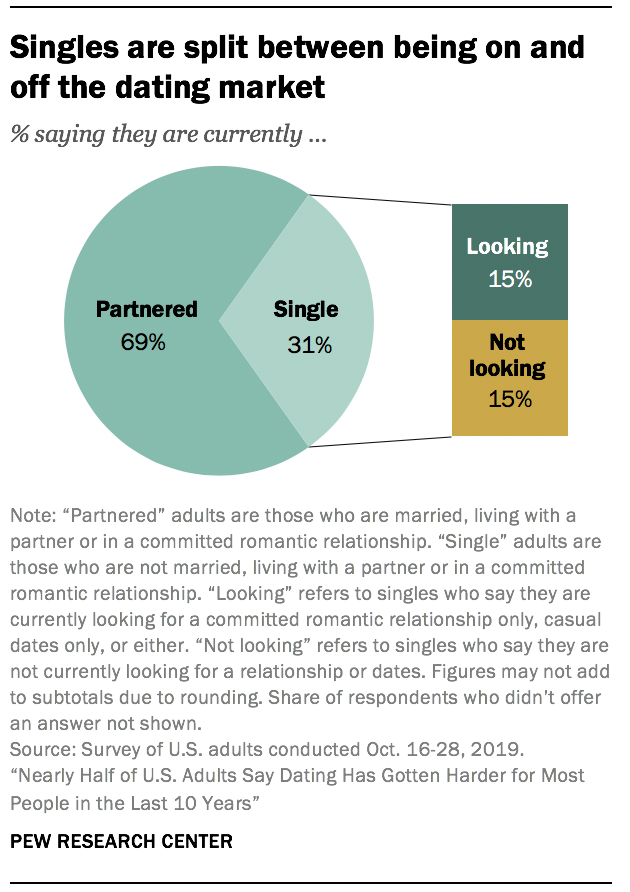 Many single adults in the U.S. are content being on their own. Of the half who are not looking for a relationship or dates at the moment, having more important priorities and enjoying being single are their top reasons why they are not looking to date.
Many single adults in the U.S. are content being on their own. Of the half who are not looking for a relationship or dates at the moment, having more important priorities and enjoying being single are their top reasons why they are not looking to date.
For those who are on the dating market, about half are open to either a relationship or casual dates, and relatively few are looking only for something casual. In particular, daters younger than age 40 are less likely than older daters to be looking for only casual dates.
A small share of singles report that they are, in fact, currently casually dating someone. This group includes singles of all ages and most of them are open to a relationship if one comes along.
Among those who are married or in a relationship, meeting through friends or family is the most popular way to have met their partner. But meeting online is common among younger adults and those who are lesbian, gay or bisexual (LGB).
Share of adults who are single varies by race, age, education and sexual orientation
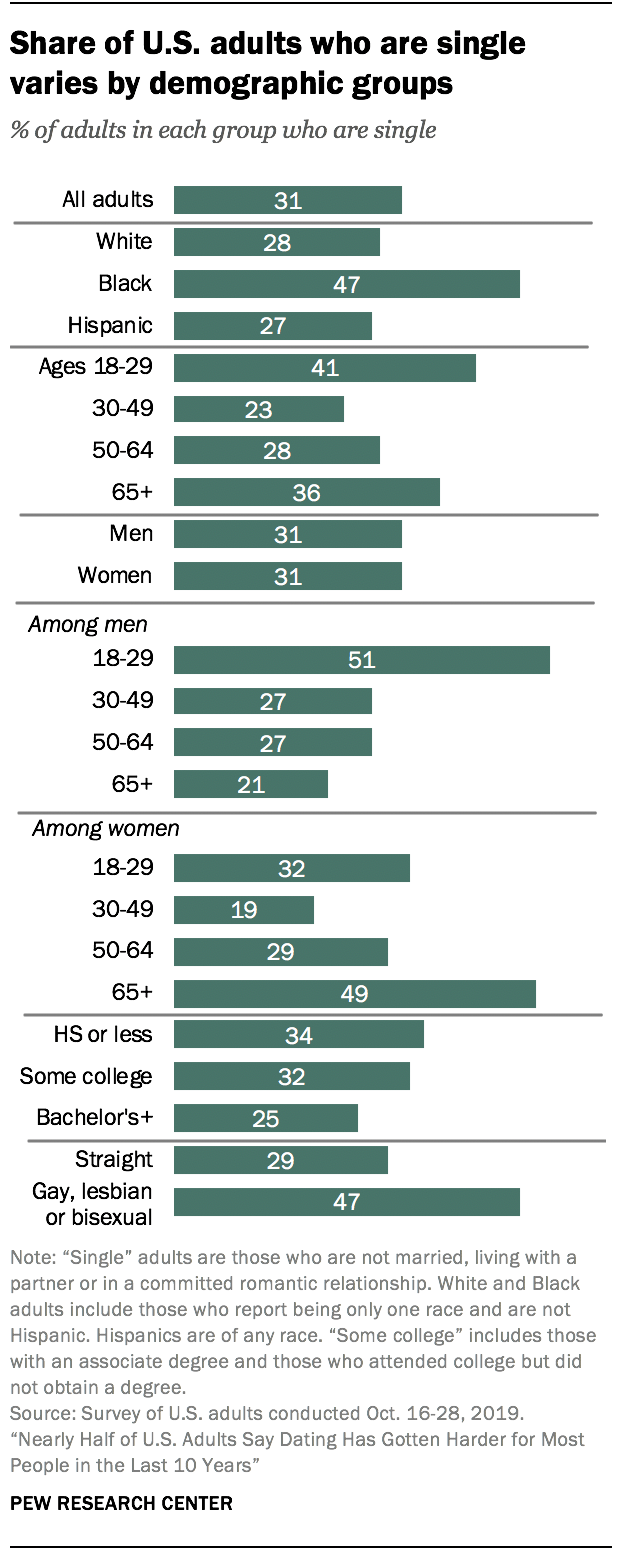 While about three-in-ten U.S. adults (31%) say they are single – that is, not married, living with a partner or in a committed romantic relationship – that share varies widely across demographic groups. The youngest and oldest Americans are the most likely to be single – 41% of those ages 18 to 29 and 36% of those 65 and older say they are single, compared with 23% of those 30 to 49 and 28% of those 50 to 64.
While about three-in-ten U.S. adults (31%) say they are single – that is, not married, living with a partner or in a committed romantic relationship – that share varies widely across demographic groups. The youngest and oldest Americans are the most likely to be single – 41% of those ages 18 to 29 and 36% of those 65 and older say they are single, compared with 23% of those 30 to 49 and 28% of those 50 to 64.
These age differences bely huge differences by gender. Among men, those younger than 30 are by far the most likely to be single: About half of men in this age group (51%) are single, compared with only 27% of those ages 30 to 49 and 50 to 64 and 21% of men 65 and older. Women, by contrast, are by far most likely to be single later in life – roughly half of women ages 65 and older are unpartnered (49%), while those ages 30 to 49 are the least likely to be single (19%). Roughly three-in-ten women ages 18 to 29 (32%) and 50 to 64 (29%) are single.
The fact that men and women tend to be single at very different stages of life reflects both men’s shorter life expectancy and their tendency to marry later in life than women.
There are also differences in the share who are single by race and educational attainment. Black adults (47%) are much more likely to be single than White (28%) or Hispanic (27%) adults. About a third of those with a high school diploma or less education (34%) or some college experience (32%) are single, compared with 25% of those with at least a bachelor’s degree.
While 47% of adults who identify as gay, lesbian or bisexual are single, only 29% of straight adults are. LGB Americans do tend to be younger on average than those who are straight (among those surveyed, the median age of LGB respondents is 35 compared with 48 among straight adults), but these differences are just as large after controlling for age. For example, 56% of LGB adults ages 18 to 29 are single, compared with 37% of those who are straight.
Many singles aren’t looking to date right now
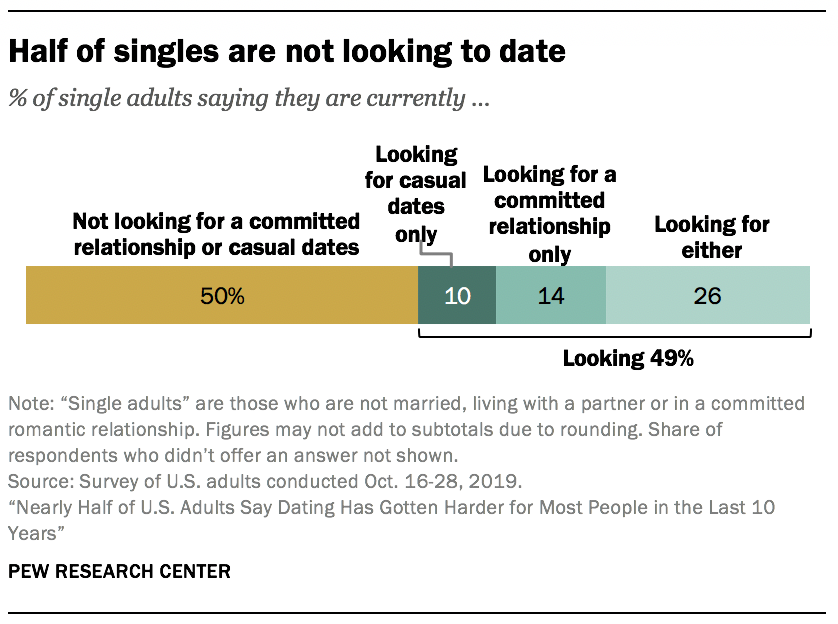 Half of singles say they are not currently looking for a relationship or dates, while about a quarter say they are looking for either a committed romantic relationship or casual dates (26%), and smaller shares say they are looking only for a committed romantic relationship (14%) or only for casual dates (10%). Whether people are looking to date or not can be explained, in part, by gender, age and past relationships – factors which are inextricably linked, but all have an impact.
Half of singles say they are not currently looking for a relationship or dates, while about a quarter say they are looking for either a committed romantic relationship or casual dates (26%), and smaller shares say they are looking only for a committed romantic relationship (14%) or only for casual dates (10%). Whether people are looking to date or not can be explained, in part, by gender, age and past relationships – factors which are inextricably linked, but all have an impact.
Majorities of singles in the 18-to-29 and 30-to-49 age groups are interested in a relationship or dates, but that’s not the case for their older counterparts. Half of those ages 50 to 64 and three-quarters of those 65 and older are not looking for either a relationship or dates at the moment.
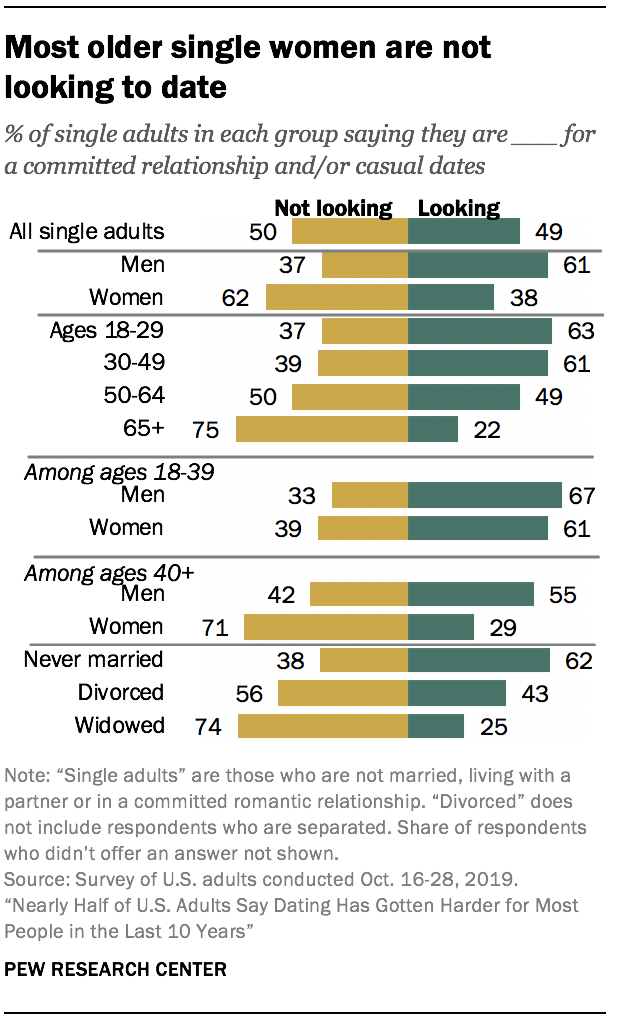 Those who have never been married are more likely to be looking to date (62%), but divorced and widowed singles lean more toward not dating at the moment (56% and 74%, respectively). This at least partly reflects the age differences among those with different marital histories.
Those who have never been married are more likely to be looking to date (62%), but divorced and widowed singles lean more toward not dating at the moment (56% and 74%, respectively). This at least partly reflects the age differences among those with different marital histories.
Men are far more likely than women to be on the dating market: 61% of single men say they are currently looking for a relationship or dates, compared with 38% of single women.
The gender differences are heavily concentrated among older singles. While men and women younger than 40 are roughly equally likely to not be looking for a relationship or dates (33% and 39%, respectively), men and women 40 and older are very different. A majority of older women (71%) say they aren’t looking to date right now, compared with 42% of men 40 and older.
Many singles on the dating market are open to either a relationship or casual dates, while one-in-five are looking only for something casual
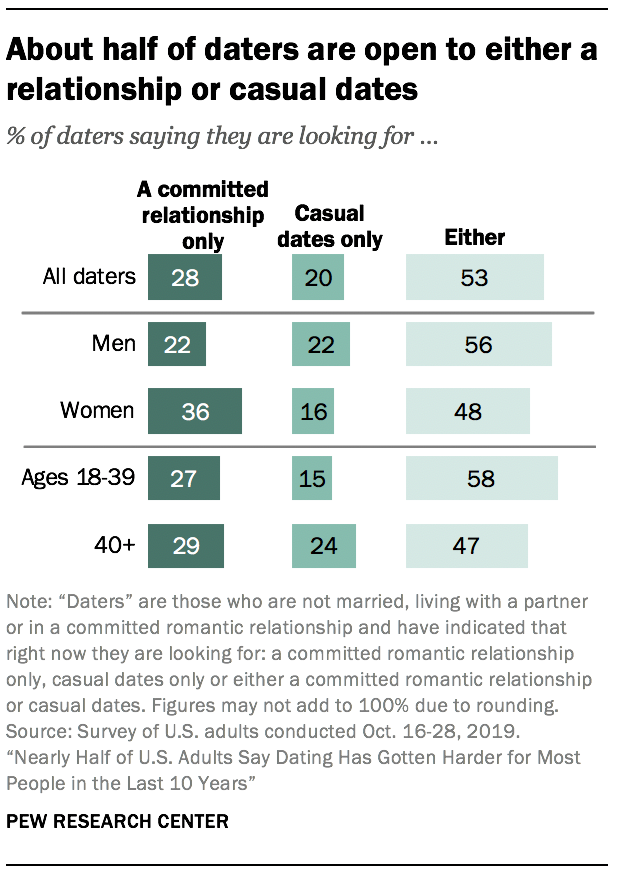 Among singles who are on the dating market, roughly half (53%) are open to either a committed relationship or casual dates. Among those who are looking for only one arrangement, more are looking for a relationship than casual dates (28% vs. 20% of singles who are looking to date).
Among singles who are on the dating market, roughly half (53%) are open to either a committed relationship or casual dates. Among those who are looking for only one arrangement, more are looking for a relationship than casual dates (28% vs. 20% of singles who are looking to date).
Women daters are significantly more likely than men to be exclusively seeking a committed relationship (36% say they are looking for this, compared with 22% of men).
While the share looking only for a relationship doesn’t vary much by age, older daters (40 and older) are more likely than younger daters to be looking only for something casual (24% vs. 15%), and less likely to be open to either a relationship or casual dates (47% compared with 58%).
A quarter of divorced, separated or widowed single people on the dating market are looking only for casual dates, higher than the share of never-married daters who are looking for the same (17%). However, these differences can primarily be explained by age and gender.
A small share of those who are not currently married, living with a partner or in a committed relationship (13%) report that they are casually dating someone. These singles are keeping their options open: 52% say they are open to either a committed romantic relationship or casual dates, while only 5% say they are not looking for a relationship or dates right now. The remaining share is split between those who are looking only for a relationship (24%) or only casual dates (19%).
Singles who aren’t looking to date cite more important priorities and enjoying the single life as reasons for not dating
Among those who aren’t looking for a relationship or dates right now (half of all singles), two reasons stand out: that they have more important priorities right now and that they just like being single. These are cited as major reasons why they are not looking by 47% and 44% of non-daters, respectively.
Roughly one-in-five single adults who are not looking for a relationship or dates right now say that being too busy (20%), not having had luck with dating or relationships in the past (18%), feeling like no one would be interested in dating them (17%) and feeling like they are too old to date (17%) are major reasons why they are off the dating market. A smaller share (11%) say they have health problems that make it difficult to date.
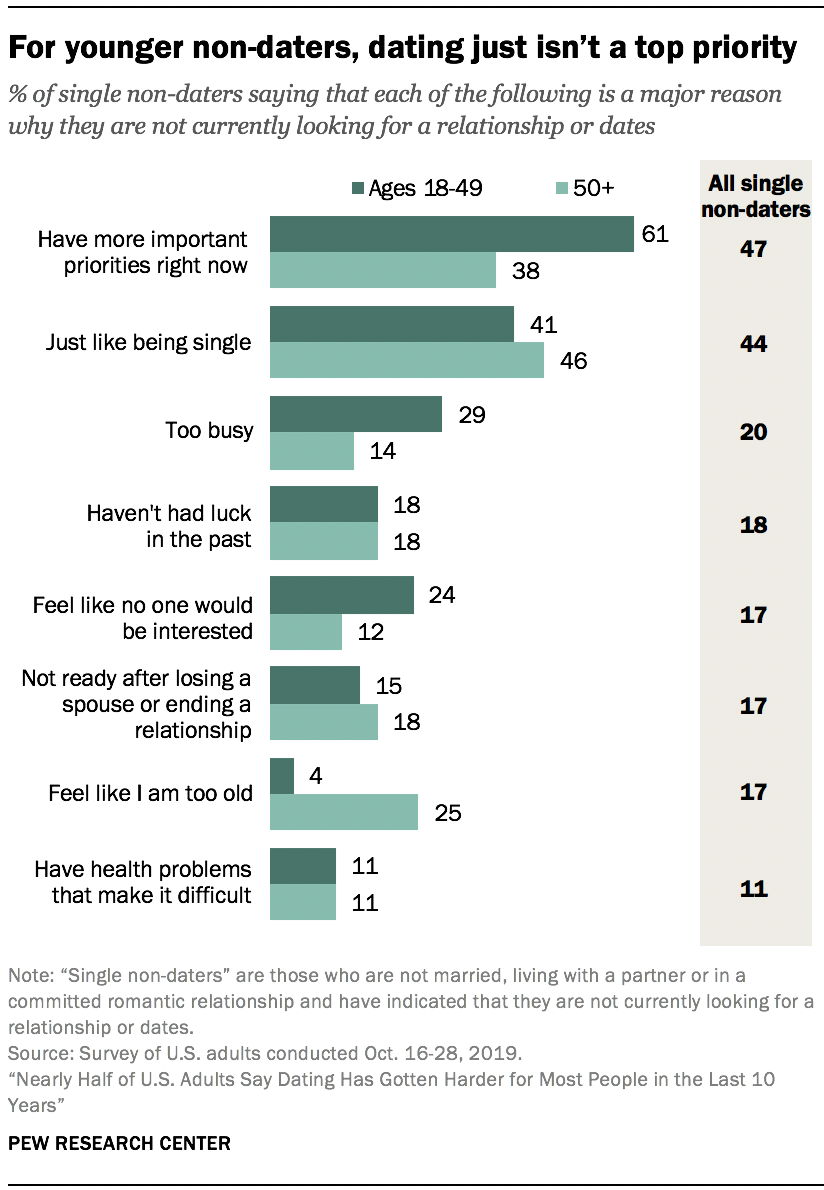 These reasons vary by age. For non-daters younger than 50, having more important priorities is the dominant reason why they are not looking for a relationship or dates (61% say so).3 Meanwhile, 38% of older non-daters say the same. Younger non-daters are about twice as likely as those ages 50 and older to say being too busy (29% vs. 14%) and feeling no one would be interested in dating them (24% vs. 12%) are major reasons why they are not looking to date at the moment.
These reasons vary by age. For non-daters younger than 50, having more important priorities is the dominant reason why they are not looking for a relationship or dates (61% say so).3 Meanwhile, 38% of older non-daters say the same. Younger non-daters are about twice as likely as those ages 50 and older to say being too busy (29% vs. 14%) and feeling no one would be interested in dating them (24% vs. 12%) are major reasons why they are not looking to date at the moment.
For their part, non-daters 50 and older are more likely to say that feeling too old to date is a major reason they’re not looking (25%) – but even 4% of those younger than 50 say the same. Non-daters age 65 and older are particularly likely to say this (30%).
Men and women see eye to eye on almost all these reasons for not looking to date. The one exception is that male non-daters are about twice as likely as female non-daters to say that feeling like no one would be interested in dating them is a major reason they’re not looking to date (26% of men say this compared with 12% of women).
Introductions through family or friends are the most common way people meet a partner, but meeting partners online is common among some groups
Looking at adults whose dating days are behind them – at least for the time being – friends and family were the most common source in helping them find a match. About a third (32%) of adults who are married, living with a partner or in a committed relationship say that is how they first met their current partner, while 18% say they met through work, 17% through school, 12% online, 8% at a bar or restaurant, 5% at a place of worship and 8% somewhere else.
Meeting online is more common among those in relatively new relationships. Among those who have been in their current romantic relationship for less than three years, meeting online is just as common as meeting through friends or family (28% met online compared with 27% through friends or family).
Younger partnered adults are more likely to have met online – 21% of those ages 18 to 29 and 15% of those 30 to 49 say they first met their partner online, compared with 8% of those 50 to 64 and 5% of those 65 and older. The youngest age group (18 to 29) is more likely than their older counterparts to have met their partners in school, while adults older than 50 are more likely to have met at work than younger people.
Meeting online is equally popular among those who say they now live in urban and suburban areas (14% of partnered adults in each type of community say they met online) but significantly less common among those living in rural areas (8%). This is the case even when taking into account that urban and suburban residents tend to be younger than those in rural areas.
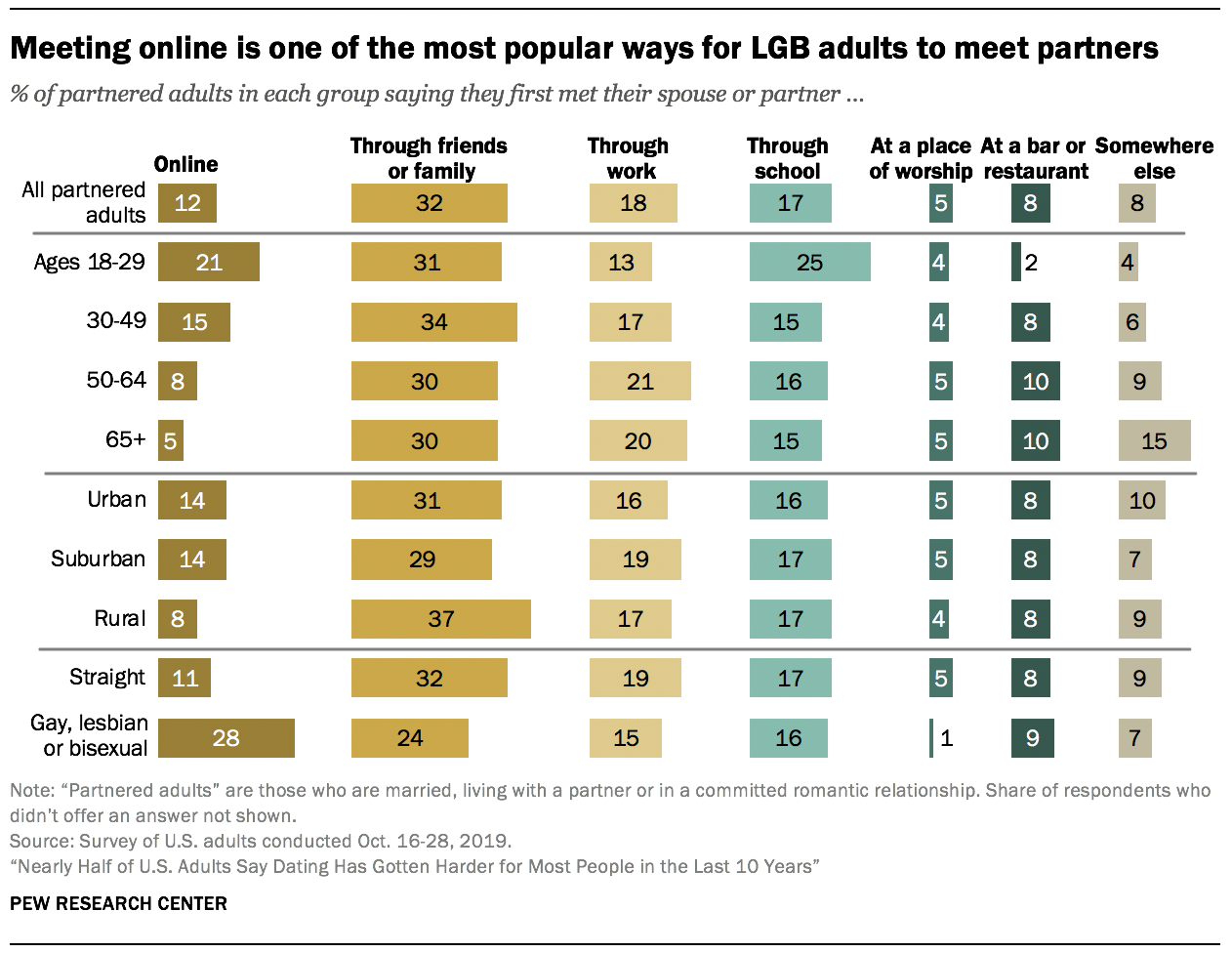
Previous research suggests that online dating is a particularly common way to meet for populations with a small pool of potential partners, such as LGB daters. The survey finds that partnered LGB adults are just as likely to have met their partner online (28%) as through friends and family (24%). This is far higher than the share of straight Americans who met their partner online (11%). Even when controlling for the fact that LGB adults tend to be younger than their straight counterparts, they are still much more likely to have met their partner online. For example, among partnered LGB adults younger than 40, 32% met their partner online compared with 17% of straight adults in the same age group.4 Single LGB adults are also more likely than single straight adults to be currently online dating (37% vs. 24%).
Meeting online doesn’t necessarily mean through an online dating site or app. While a majority of those who met their partner online say they met through a dating site or app (61%), a significant share reports meeting through a social media site or app (21%). Smaller shares say they met their partner in an online discussion forum (10%), a texting or messaging app (3%) or online gaming (3%).
Singles who have never been in a committed relationship tend to be young and not looking for a relationship or dates
About a third of never-married single adults (35%) say that they have never been in a committed romantic relationship. These singles are younger on average – single adults who have never been in a relationship have a median age of 24, compared with 35 among those who have been in a relationship. Still, 21% of never-married singles age 40 and older say they have never been in a relationship. Roughly four-in-ten (42%) of those younger than 40 say the same.
Never-married single men and women are about equally likely to have never been in a relationship (35% and 37%, respectively).
Those who have never been in a relationship are less likely to be looking for a relationship or dates than never-married singles who have some experience with committed relationships (53% vs. 67%).


